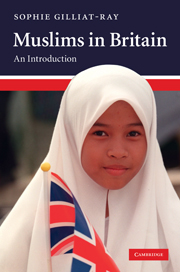Book contents
- Frontmatter
- Contents
- List of figures
- List of tables
- Preface
- Acknowledgements
- List of abbreviations
- PART I HISTORICAL AND RELIGIOUS ROOTS
- PART II CONTEMPORARY DYNAMICS
- 5 Profiling British Muslim communities
- 6 Religious nurture and education
- 7 Religious leadership
- 8 Mosques
- 9 Gender, religious identity and youth
- 10 Engagement and enterprise
- Epilogue
- Appendix: Source notes for researchers
- Glossary
- References
- Index
9 - Gender, religious identity and youth
Published online by Cambridge University Press: 05 June 2012
- Frontmatter
- Contents
- List of figures
- List of tables
- Preface
- Acknowledgements
- List of abbreviations
- PART I HISTORICAL AND RELIGIOUS ROOTS
- PART II CONTEMPORARY DYNAMICS
- 5 Profiling British Muslim communities
- 6 Religious nurture and education
- 7 Religious leadership
- 8 Mosques
- 9 Gender, religious identity and youth
- 10 Engagement and enterprise
- Epilogue
- Appendix: Source notes for researchers
- Glossary
- References
- Index
Summary
INTRODUCTION
Much research on gender in relation to British Muslims so far has focused on women, and especially the emerging generation of young British-born Muslim girls. The hopes and expectations of young women in relation to marriage and education, for example, have been studied in some depth (Afshar 1998; Basit 1995; Dwyer 1999c; Jawad and Benn 2003; Khanum 1992a; Knott and Khokher 1993; Mirza 1989). The problems facing women in terms of social control by religious authorities (Sahgal and Yuval-Davis 1992) and issues such as forced marriages, domestic violence and female circumcision have emerged as major concerns. However, ethnographic research on gender in the past decade has shifted its focus towards Muslim men, and especially young men (Alexander 2000; Archer 2009; Hopkins 2006). Likewise, there have been some important recent studies involving British Muslim women that centralize their emerging economic and civic roles, rather than highlighting stereotypical concerns with marriage and the family. New topics, including youth work with Muslim girls (Cressey 2007) and participation in the labour market and civil society (see for example Ahmad et al. 2003; Benn 2003; Bowlby and Lloyd Evans 2009), are now being tackled seriously and with new insights.
This chapter surveys the literature concerning British Muslim masculinity and femininity, and critically evaluates gender and gender relations among Muslims in Britain more broadly.
- Type
- Chapter
- Information
- Muslims in Britain , pp. 206 - 233Publisher: Cambridge University PressPrint publication year: 2010

